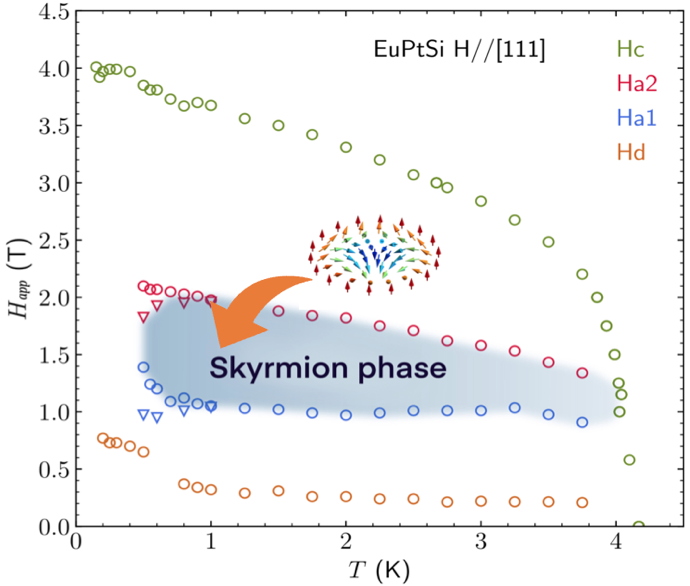 General Scope
General Scope
Topological spin textures are a source of unusual physical phenomena owing to the interplay between magnetism and topology. A most prominent example is the magnetic skyrmion (see inset Figure), a nanosized noncollinear spin structure with particle-like topological states which can move with a low depinning current density, enabling to develop novel spintronics. Hence, magnetic skyrmions are regarded as small and energy-efficient information cells having the potential to develop high-density, low-power, and multi-functional devices for memory and logic applications. This drives a line of research concentrating on controllable and efficient ways to create, delete, manipulate, and excite magnetic skyrmions. One approach to manipulate spin textures is to use temperature gradients.

Phase diagram of the chiral antiferromagnet EuPtSi exhibiting a skirmion phase at low temperature, inside an antiferromagnetic phase.
 Subject
Subject
We propose an experimental and fundamental research project which will explore different types of magnetic materials (EuPtSi, Gd2PdSi3, MnP, CrAs) with exotic magnetic states (skyrmion and helimagnet states). The goal is to use mainly thermoelectric effects under extreme conditions (low temperature, high magnetic field and high pressure), to characterize these exotic spin textures, understand the different competing orders present in these magnetic materials and ultimately displace these spin texture with the application of a thermal gradient. We have recently revealed a metastable behavior of the skyrmion phase in the cubic chiral antiferromagnet EuPtSi, see Figure, underlying the complexity of the stability of the skyrmion phase.
 Experimental environment:
Experimental environment:
The candidate will benefit from a unique scientific environment: a dedicated dilution refrigerator (50mK-16T), a large range of experimental probes (resistivity, Hall effect, specific heat, thermal conductivity and thermoelectric effects...), the possibility to grow and characterize his own material in the laboratory, a strong interplay with local theoreticians.
 Possible collaboration and networking
Possible collaboration and networking
The internship proposal is based on a long-term collaboration with the high magnetic field facility (LNCMI) in Grenoble and with close collaborators in Japan.
 Required skills
Required skillsMaster or Engineering degree. Skills on solid state physics or nanophysics will be appreciated. Motivation for experimental studies is needed.